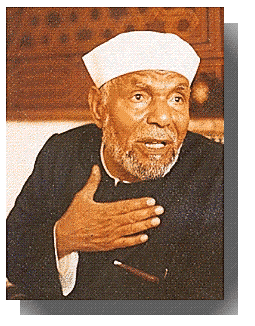The Muslim Magazine is honored to present a new series on the spiritual experiences of the renowned scholar, the late Imam Metawalli Ash-Sha`rawi. Near the end of his days, Shaykh Sha`rawi revealed the many extraordinary occurrences he witnessed during his years as one of Egypt’s highest and most-followed scholars.
PROFILE
Shaykh Metwalli Sha’rawi 1911 – 1998

Raised in Egypt’s Nile Delta village al-Dacadous, Shaykh Sharawi, who held moderate mainstream views of Islam, graduated in 1943 with an Islamic degree specializing in Arabic language. The shaykh taught at Saudi Arabia’s King Abdel Aziz University in the 1950s and 60s, and later served as Egypt’s Religious Endowments Minister in the late 70s.
When Shaykh Sha’rawi returned to Egypt in 1975, he had a lasting impact on Egypt’s television audience when he appeared in the weekly program Nur `Ala Nur. His lecturing style diverged greatly from that of traditional Azharites, conveying his wealth of Qur`anic knowledge in a style and language understandable to the common man. Shaykh Sha`’rawi’s fame skyrocketed. The shaykh was universally regarded as Egypt’s top preacher. His books, tapes and videos are popular all over the Muslim world and he was given prestigious awards by a number of the Gulf States.
The shaykh’s major works include the encyclopedic Interpretation of the Holy Koran and The Great Fatwas, a collection of religious edicts and answers to questions about Islam. Shaykh Sha`rawi hosted a weekly television show during which he interpreted the Qur`an to a live audience. The show was aired daily during the Moslem fasting month of Ramadan. Shaykh Sha`rawi passed away in June 1998.
Taking place in many of the mosques and tombs of Ahl al-Bayt, the Family of the Prophet (s), these profound mystical encounters will astound the reader. Ash-Sha`rawi Unveils His Secrets was developed from interviews with the shaykh in the last year of his life, conducted in the courtyard of the mosque of Sayyida Nafisa at-Tahira, granddaughter of the Prophet (s) and one of the highly notable waliyyas (lady saint) of Cairo.
This holy mosque, like others in Cairo that house the blessed remains of Ahl al-Bayt, contains the grave of our lady Zainab (r). Millions of believers flock here each year in commemoration of the struggle waged by Ahl al-Bayt for the sake of the religion, to celebrate their lives that illuminate the history of Islam.
Amazing Accounts Revealed
In the series we intend to relate what Shaykh Sha`rawi describes as the glad tidings he received while visiting the Mosque of the Prophet (s) when the Prophet (s) appeared to him while he was in a waking state. Other narrations include the story of Shaykh Sha`rawi’s meeting with Sayyida Nafisa (r) , the story of the man who whispered a secret in the shaykh’s ear during his visit to Sayyida Sakina (r) (granddaughter of the Prophet (s)), and his spiritual encounter with Sayiddina Ibrahim al-Khalil in Makkah.
Other fascinating accounts include his dispute with the Mufti of Saudi Arabia, Abdul Aziz bin Baz, after he authorized moving Maqam Ibrahim back from its location near the Ka`aba, a disagreement which Shaykh Sha’rawi escalated until it reached the ears of King Saud. We will disclose the secrets of his vision of Sayyidina Ibrahim (as) and what he told him to say to the king, resulting in King Saud’s rejecting the decision to move the Maqam from its original location. We will also relate in this series the account of the shaykh’s meeting with the famous waliullah Sayyidina Ahmad al-Badawi (d 1276) and the good tidings he gave him: that he would go to work in Makkah.
Prophet’s (s) Granddaughter and Imam Shafi`i
Sayyida Nafisa was born in Makka on 11 Rabiul Awwal 145 H. She married at the age of 16, and traveled to Egypt in 193 H. Imam Shafi`i studied under her, and his custom was to visit her before he lectured and on his way home at night. He normally prayed taraweeh in her mosque every Ramadan. He studied hadith under her. If he happened to be sick and unable to visit her, he would send a student to ask her to pray for him. On such occasions, she lifted her hands and beseeched Allah to cure him, which would inevitably be granted.
In his will, Imam Shafi`i, who died in Rajab 204 H., requested that Sayyida Nafisa pray janaza over him. His coffin was placed in front of her home in Fustat. Sayyida Nafisa then ordered Abu Yaqub al-Buwaiti to conduct the funeral prayer over him, while she followed him in prayer.
On Tassawuf and Sufi Orders
We asked Imam Metawalli Sha’rawi about the meaning of tassawuf and the Sufi orders. He said, “At-Tassawuf is the essence of religion. It has been mentioned by the Prophet (s) as the station of excellence (maqam al-ihsan).”
Allah (swt) described the people of tasawwuf, saying to the Prophet (s):“And keep yourself content with those who call on their Lord morning and evening, seeking His Face; and let not thine eyes pass beyond them, seeking the pomp and glitter of this life; nor obey any whose heart We have permitted to neglect the remembrance of Us, one who follows his own desires and whose affair has become all excess.” Surat al-Kahf, verse 28
An explanation of this verse published in Madina explains, “The true servants of Allah are those whose hearts turned to Him morning, noon, and night and who seek not worldly gain but Allah’s presence and nearness. Even if they are poor in this world’s goods, their society gives far more inward and spiritual satisfaction than worldly grandeur and worldly attractions.” Thus we see that Shaykh Sha`rawi’s understanding goes back to the concept of zuhd (abstention from worldliness), a focus on the afterlife and perfecting one’s character.
“In Egypt there are many tariqats (paths, sufi orders). One is the tariqat al-Ahmadiyya or al-Badawiyya which goes to back to Ahmad al-Badawi. Another is the Burhaniyya, which relates to Sayyid Ibrahim al-Dusougi, a great wali of Egypt. Then there is the tariqat al-Shadiliyya which is related to Abul Hassan al-Shadili, and there is tariqat al-Rufai’yya which relates to the Sayyidi Ahmad al-Rufai. There is the tariqat al-Naqshbandiyya, which traces its roots to Bahauddin Naqshband. I belong and took initiation in the tariqat al-Baaziya, Ashab al-amaim al-khadra, “people of the Green Turbans” related to Sayyidina al-Baaz, Abdul Qadir al-Jilani.
On His Noble Lineage and Following a Shaykh
I said, “We never heard of this Sufi order before. What is it” The Shaykh replied, “That Sufi Order only includes within its ranks the descendants of al-Hassan and al-Hussain, known as al-Ashraf.” I was stunned. As the shaykh had been speaking, he suddenly stopped and went into a deep and peaceful dhikrullah, chanting the names of God for some time and tears fell from his eyes. That was the first time that Shaykh Shar`awi had ever revealed the secret of his lineage–that he is a descendant of the Prophet (s).
He then gave me a photo of a man wearing a green turban to be used with this interview. He revealed the secrets that no one had ever heard, neither from among his students, nor from among the millions of common people and intellectuals from around the world who love him and his explanations of Qur`an and the teachings of Islam.
I asked him, “Whose picture is this” Shaykh Sha’rawi spoke of the honor to follow the man in the picture, a Sufi shaykh, saying, “He is the spiritual teacher and shaykh of the Sufi order al-Baaziyya. His name is Shaykh Ahmad al-Saud.” Though I had been attending the shaykh’s lectures all of my adult life, I never heard that he carried such a distinguished lineage, nor that he followed a Sufi shaykh.
I asked the shaykh’s son, Abdur Raheem ash-Sha’rawi about his father’s lineage to the Prophet (s) and his affiliation to the Sufi order al-tariqat al-Baaziyya which traces its lineage back to Shaykh Shamsuddin al-Baaz. He said, “The descendants of the Prophet (s) by themselves form a complete tree with many extended branches. We come from among its branches. Our ancestors came from al-Hijaz, from a straitened valley called al-Sha’rawi, and they settled on the east side of Egypt, al-Sharqiyya. From al-Sharqiyya, my grandfather Sidi al-Mutawalli, a great Sufi shaykh, moved to al-Dacadous. He was accompanied by Sidi Abdul Hafiz, his cousin. Sidi Abdul Hafiz was carrier of the flag of the Descendants of the Prophet (s) (Bayrak al-Ashraf), which the tariqat al-Baaziyya is honored to display in all great events, especially on Mawlid an-Nabi (s), the Prophet’s birthday.”
A Life of Good Works
The shaykh sent me to his village al-Dacadous. Abdur Raheem showed me what his father had done for the poverty-stricken hometown in which he had been raised. With the money that Allah bestowed on him in his later life, he built orphanages, hospitals, clinics and an Islamic institute connected to the University of al-Azhar. The university he had established in al-Dacadous cost millions of dollars. He provided scholarships to more than 250 families so that their children could attend the university. This is in addition to what the shaykh had done in Cairo, in the area of Sayyida Nafisa’s mosque and grave. We will mention those accomplishments in later parts of this series. I returned from Dacadous with many different stories pounding in my brain: the extraordinary revelation of his lineage to the Prophet (s), the detailed secrets he revealed regarding his spiritual relationships with his noble ancestors al-Hassan and al-Hussain, and particularly the shaykh’s encounters with the Prophet (s) in many different visions over the course of his life. It took me over nine months to transcribe this vast amount of information from our interviews into this book.
He described to me his long spiritual journey in the spacious courtyard of the family of the Prophet (s), full of observations and experiences and events and stories that are astonishing, stunning and surprising. Secrets were revealed for the first time in his life that will come out in the following series of articles.
The next part of this series will describe Imam Sharawi’s lengthy dialogue with Sayyida Nafisa at her tomb in Cairo.
Excerpted from the book:Ash-Sha`rawi Unveils His Secrets with Sayyida Zainab and Sayyidina Hussain Egypt, 1997, Dar Akhbar al-Yawm publisher



